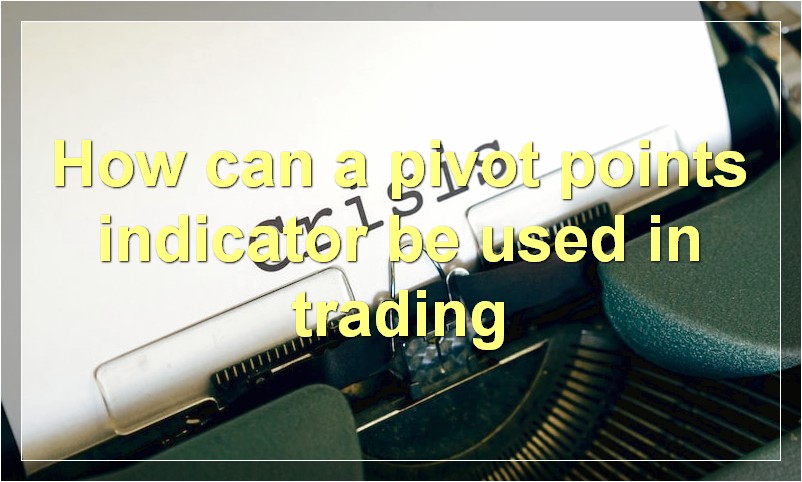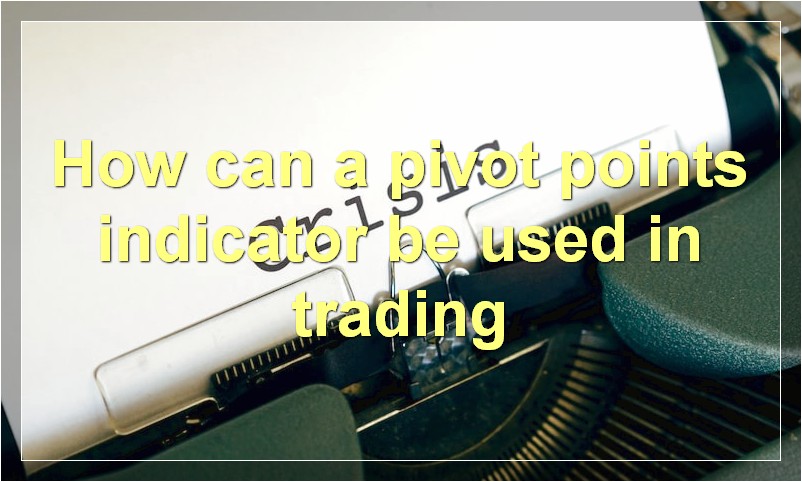If you want to get ahead of the competition, you need to know about pivot points. This indicator is essential for any trader who wants to make a profit.
What is a pivot points indicator
A pivot point is a technical analysis indicator used to determine the overall trend of the market over different time frames. The pivot point itself is simply the average of the high, low and close prices from the previous trading day.
Pivot points are used by traders as a predictive indicator and denote areas of support or resistance in the market. In other words, pivot points can be used to identify potential turning points in the market.
The most common time frames used to calculate pivot points are monthly, weekly and daily. However, pivot points can also be calculated for shorter time frames such as hourly or even intraday.
Pivot points are generally calculated using closing prices but can also be using highs or lows. The main advantage of using closing prices is that they are more reliable than using highs or lows, which can be more volatile.
The main disadvantage of pivot points is that they are lagging indicators, meaning that they only provide information on past price movements. This means that they cannot be used to predict future price movements.
Despite this, pivot points can still be useful in identifying potential support and resistance levels in the market. These levels can then be used to place stop-loss orders or take profit orders.
How can a pivot points indicator be used in trading

If you are new to trading or just starting to learn about technical analysis, one of the first things you will come across is the concept of pivot points. Pivot points are simply a technical indicator that is used to identify potential support and resistance levels in the market. These levels can be used by traders to enter or exit trades, as well as to set stop-losses.
Pivot points are calculated using the high, low, and close prices from the previous day (or week, for weekly pivot points). The most common method of calculating pivot points is the standard pivot point, which is shown below:
Pivot Point (PP) = (High + Low + Close) / 3
Once the pivot point has been calculated, the following support and resistance levels are then derived:
First support level (S1) = (2 x PP) – High
First resistance level (R1) = (2 x PP) – Low
Second support level (S2) = PP – (R1 – S1)
Second resistance level (R2) = PP + (R1 – S1)
Third support level (S3) = S1 – (R2 – S2)
Third resistance level (R3) = R1 + (R2 – S2)
As you can see from the formulas above, the pivot point itself acts as the first level of support or resistance. If the market is trading above the pivot point, then the first level of support is at the pivot point itself. Conversely, if the market is trading below the pivot point, then the first level of resistance is at the pivot point.
The other important thing to note about pivot points is that they are constantly changing. This means that if you are using them to trade, you need to make sure that you are always using the most up-to-date levels. One way to do this is to use a daily or weekly pivots indicator, which will automatically update the pivot point levels for you based on the most recent price data.
What are the benefits of using a pivot points indicator
A pivot points indicator is a tool that technical analysts use to identify potential support and resistance levels in the market. Pivot points are calculated using the high, low, and close price from the previous period. The most common timeframes used to calculate pivot points are daily, weekly, and monthly.
Pivot points can be used to identify market trends and potential reversals. They can also be used to set entry and exit points in the market. Many traders believe that pivot points are a valuable tool, as they can help to make trading decisions based on objective criteria.
There are several benefits of using a pivot points indicator. First, it can help to identify potential support and resistance levels in the market. Second, it can be used to set entry and exit points in the market. Third, it can help to make trading decisions based on objective criteria. fourth, it can help to reduce the risk of trading.
How does a pivot points indicator work
Pivot points are used by traders as a predictive indicator and denote levels of technical significance. Pivot points are calculated using the high, low and close prices of a previous day, week or month. The most popular pivot point is the daily pivot point.
The calculation for a daily pivot point is as follows:
Pivot point (PP) = (High + Low + Close)/3
First support level = 2 * Pivot point – High
First resistance level = 2 * Pivot point – Low
Second resistance level = Pivot point + (High – Low)
Second support level = Pivot point – (High – Low)
What are some of the best pivot points indicators
Some of the best pivot points indicators are Fibonacci retracements, support and resistance levels, and moving averages. These indicators can help you identify key levels where the market is likely to reverse direction or continue in its current trend. By using these indicators, you can make better-informed trading decisions and improve your chances of success.
How do I choose a pivot points indicator

There are a few things to consider when choosing a pivot points indicator. First, what is your trading style? Are you looking for long-term or short-term opportunities? Second, what are the timeframes that you are most comfortable trading in? Third, what is your risk tolerance?
If you are looking for long-term opportunities, then you will want to choose an indicator that is more accurate over longer periods of time. If you are comfortable trading in shorter timeframes, then you can afford to use an indicator that is less accurate but faster at identifying potential trade opportunities. Finally, if you have a higher risk tolerance, you can afford to use an indicator with wider margins of error.
The most important thing is to find an indicator that suits your trading style and comfort levels. There is no “right” or “wrong” pivot points indicator – only the one that works best for you.
What are the most popular pivot points indicators
Pivot point indicators are one of the most popular technical indicators used by traders. A pivot point is simply a point at which the price has reversed direction. Pivot points are used to identify potential support and resistance levels.
There are a number of different ways to calculate pivot points, but the most common method is to take the average of the high, low, and close prices from the previous day. This information is then used to generate three main support levels and three main resistance levels.
The main support levels are referred to as S1, S2, and S3. The main resistance levels are referred to as R1, R2, and R3. These levels can be used to place orders or simply to monitor price action.
Pivot points are popular because they are relatively easy to calculate and they can be used in conjunction with other technical indicators. For example, many traders use pivot points in combination with Fibonacci retracement levels.
If you are new to trading, then pivot points can be a helpful tool to add to your arsenal. However, it is important to remember that no indicator is perfect and that pivot points should not be used in isolation.
What are the pros and cons of using a pivot points indicator
When it comes to technical analysis, there are a number of different indicators that traders can use to help them make decisions about when to enter and exit the market. One of these indicators is known as pivot points. Pivot points are calculated using the high, low, and close prices from the previous period and then projected into the future. This indicator can be used to identify potential support and resistance levels for the current period.
Pivot points are a popular indicator because they are relatively easy to calculate and can be used in conjunction with other technical indicators. However, there are also some drawbacks to using pivot points. One of the main drawbacks is that they only provide a limited amount of information. For example, they do not take into account the volume of trading or the open price. In addition, because they are based on past prices, they cannot predict future price movements with 100% accuracy.
Overall, pivot points can be a useful tool for traders, but it is important to understand their limitations.
What are some tips for using a pivot points indicator
If you’re looking to use a pivot points indicator to help your trading, here are a few tips to keep in mind:
1. First and foremost, make sure you’re using an accurate and reliable indicator. There are a lot of options out there, so do your research and choose one that suits your needs.
2. Pivot points can be used on any time frame, but they’re most commonly used on daily or weekly charts.
3. Pay attention to Support and Resistance levels. These are key areas where the price is likely to pause or reverse direction.
4. Use other indicators in conjunction with pivot points to help confirm price movements. For example, if you see a bullish reversal pattern forming at a support level, that’s a good sign that the price is about to head higher.
5. Finally, don’t get too caught up in the details. Pivot points are just one tool in your toolbox, so use them as part of a broader strategy.
How do I troubleshoot a pivot points indicator
If you are having trouble with your pivot points indicator, there are a few things you can try. First, make sure that you have the most recent version of the indicator. If you are still having trouble, try changing the settings or inputting different data. Finally, if all else fails, you can contact customer support for help.

